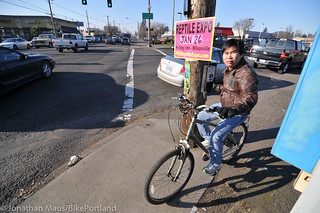
auto-centric streets like SE Foster.
(Photo by J. Maus/BikePortland)
A grant from the State of Oregon will help the City of Portland continue their work to tame dangerous arterial streets.
Last Wednesday, City Council accepted an $85,000 grant from the Oregon Department of Transportation’s Transportation Safety Division. The funds — which amount to just 0.25% of the ODOT Safety Division’s $33 million annual budget — will be matched with $63,750 from the Portland Bureau of Transportation and will be applied toward, “specific engineering, enforcement, and education strategies and proven traffic safety countermeasures on identified Portland arterials” (according to Council ordinance).
Arterial streets remain a major problem in the Portland metro area. According to PBOT statistics, 40% of all “vehicle travel” (a phrase that only refers to motor vehicles) occurs on arterials (which make up only 5% of the road network), yet they are responsible for 59% of serious crashes/collisions, 67% of serious collisions that involve someone walking and 52% of the serious collisions involving a bicycle rider.
According to PBOT Project Manager Gabriel Graff, the grant marks a change in direction for their High Crash Corridor program. That program, which launched as a three-year initiative back in 2010, identified the Portland streets with the highest concentration of traffic crashes and collisions. In those first three years, Graff said the program focused on three specific corridors per year. Working with stakeholders, PBOT created a detailed safety plan for each street. “Now we’re moving into the community phase,” says Graff.
With the corridors and issues identified, PBOT plans to apply specific National Highway Traffic Safety Administration (NHTSA) countermeasures. Here’s more from PBOT’s grant application:
“The HCC [High Crash Corridor] program is well-positioned to implement specific education, enforcement and engineering countermeasures to address three of the identified safety problems: aggressive driving, pedestrian safety, and bicycle safety.”
Graff says these latest grant funds will be applied to projects “where we have community support.” He gave recent examples of road diets on SE Division and NE Glisan as places that had been identified in the High Crash Corridor program and where community activists clamored for specific projects (on Glisan it came after a fatal collision at NE 78th last year).
But don’t expect engineering and design changes to come from this specific project. Out of the $148,750 total project funds, just $21,961 is set aside for “engineering enhancements”. Most of the money will go toward two new PBOT staff positions (valued at just under $100,000) and marketing materials ($8,500). That being said, these staff positions are needed to vet any potential infrastructure projects and to carry out the public process required before they’re implemented.
Learn more about PBOT’s High Crash Corridor program on their website.





Well, I’d much rather hear about The Foster Road plan fixing the bike gap from the original design, but if these two positions are filled with smart and persuasive advocates for complete streets, then OK I guess.
We have so much work to do, and so much time is being wasted on having the same arguments and debates. Community outreach is great, but giving voice—or veto power—to people who are willfully ignorant is not going to get anything done.
Oh, and happy birthday, Jonathan!
“Arterial streets remain a major problem in the Portland metro area. According to PBOT statistics, 40% of all “vehicle travel” (a phrase that only refers to motor vehicles) occurs on arterials (which make up only 5% of the road network), yet they are responsible for 59% of serious crashes/collisions, 67% of serious collisions that involve someone walking and 52% of the serious collisions involving a bicycle rider.”
Is this surprising to anyone? The purpose of an arterial is to collect from neighborhood/local streets, so of course you would expect more “vehicle travel” on them. You would also expect more collisions due to the increased volume (and the increased speeds on arterials).
Sorry, I guess I’m just not understanding the purpose of this paragraph as it seems pretty obvious. Maybe I’m just hung up on the “make up only 5%” portion.
What seems noteworthy is that with 40% of the vehicle travel, you would expect – all else being equal – 40% of the crashes. But they’re considerably higher in the categories listed; hence, the problem.
find me a study that strongly links speed or volume to crash fequency. It sounds good on the surface, but freeways have high speeds and volumes, but are not where the greatest number of crashes occur. Most crashes happen off the freeways.
It’s got more to do with conflict points, vehicle operator work load, and, IMO, lack of experience with crashes. People who’ve been in or witnessed a crash are much more likely, IMO, to be cautious when moving about.
Sure, but the comparison to freeways is unfair. I think a better comparison would be to neighborhood streets which have a more similar level of intersections/driveways, etc. And clearly based on these numbers it looks like Arterials are seeing more collisions than neighborhood streets.
How did it get this bad?